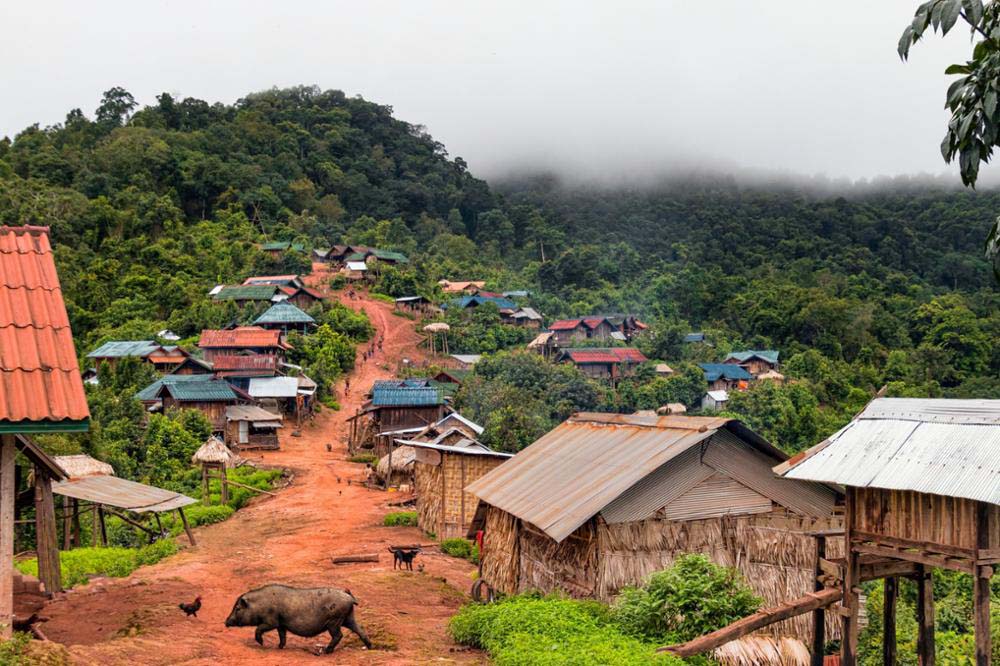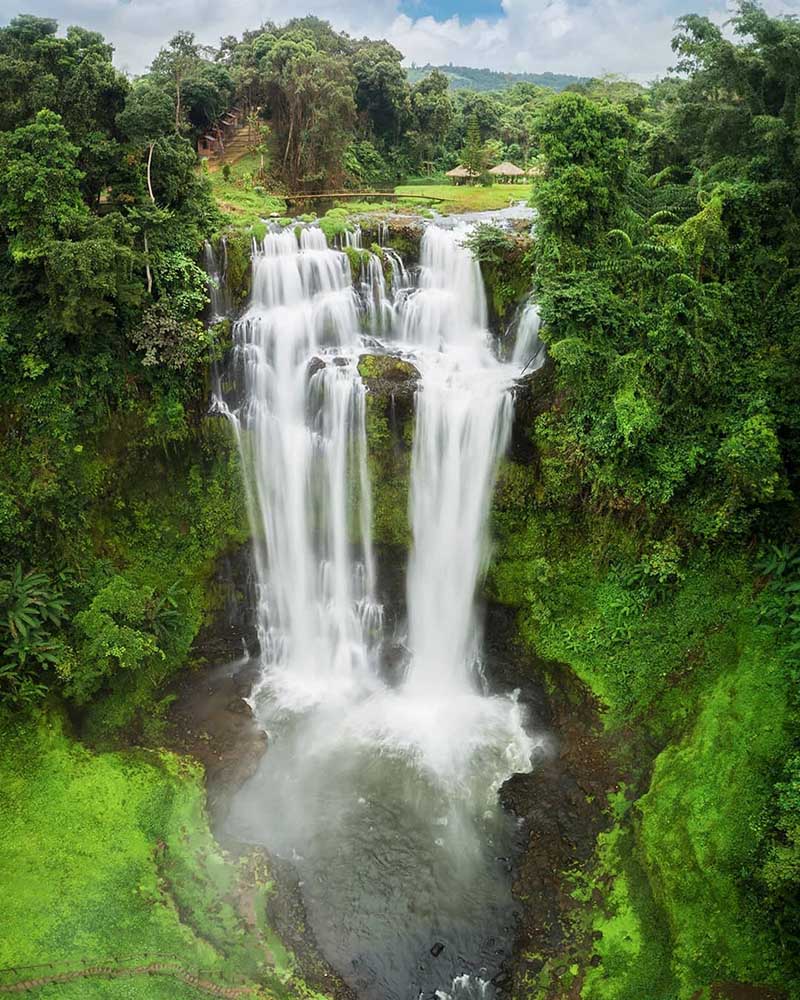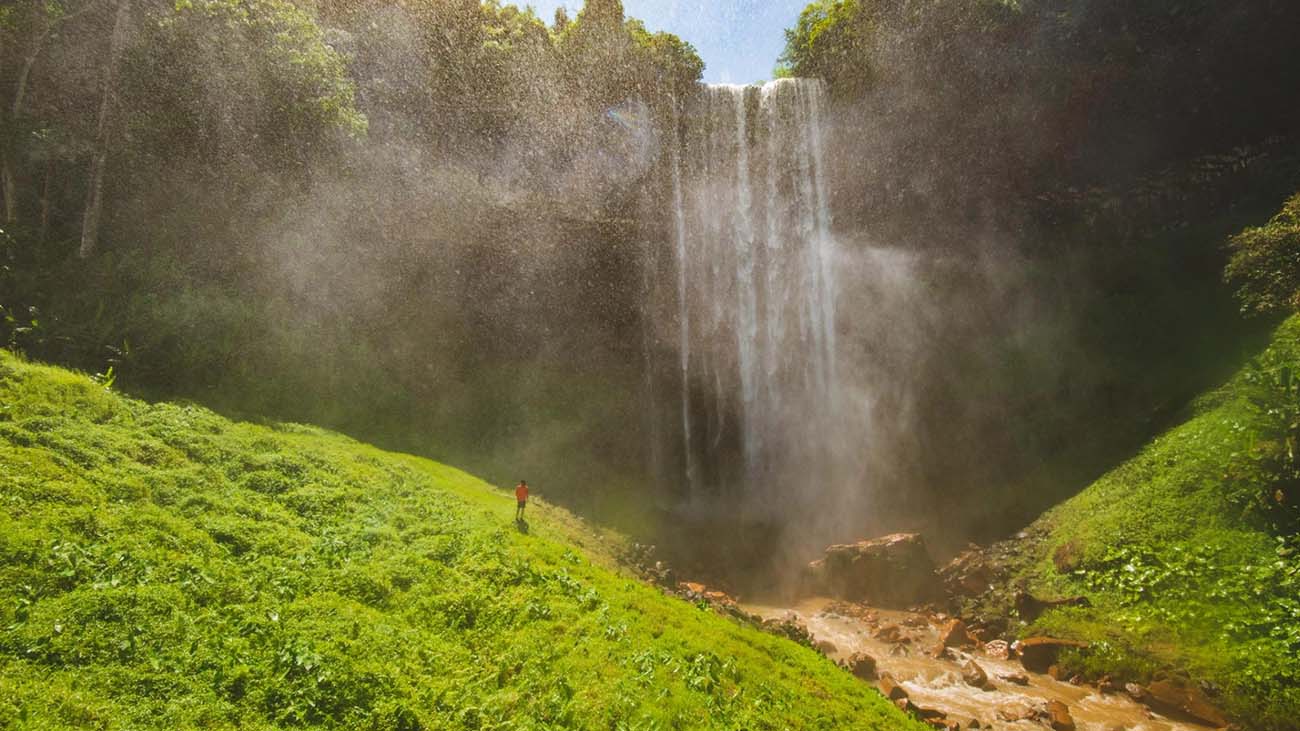Before delving into the specifics of the recommended national parks in Laos to visit, let me provide a brief overview of the expected costs for your excursion. Transportation expenses vary, so I will discuss them in each national park introduction. In addition, other expenses you should consider include:
|
Entrance fees |
0.1 - 12 USD |
|---|---|
|
Overnight at homestay |
2 - 20 USD |
|
Boating/Kayaking |
4 -10 USD |
|
Food |
0.5 - 3 USD/dish |
|
Tuk-tuk transportation rental |
1 - 5 USD for a short ride |
|
Motorbike rental |
5 - 10 USD/day |
|
Local guide |
5 USD |
|
Village fund |
3 USD |
That's the cost information. Now, let’s get into details about the national parks, their locations, how to get there, and activities you can undertake to make the most of your time in Laos national parks.
Nam Ha National Protected Area

A village in the Nam Ha area
The Nam Ha Mountain area extends from the Chinese border, encompassing approximately 222,400 hectares, and making up around 24% of the province. It serves as the residence for ethnic communities with 25 villages.
The protected area comprises forests that serve as habitats for numerous wild animal species (including tigers, clouded leopards, monkeys, gibbons, Asian elephants, bears, and more). Additionally, the region features rivers, caves, natural waterfalls, and villages where inhabitants have resided for a long time.
-
Location: Luang Namtha, Northern Laos.
-
How to visit: Travel 308 km from Luang Prabang: 8 hours travel by minivan (about 45 USD).
-
What to do:
-
Hiking and Trekking (day and overnight trek available): Luang Namtha, Muang Sing, Muang Long, Nalae, Viengphoukha, and Nalan Trail.
-
Birdwatching, wildlife viewing.
-
Visit Caves and waterfalls: Kao Rao Cave, Nam Dee Waterfall, Pha Yuang Waterfall, Nam Keo Waterfall, etc.
-
Kayaking on Nam Ha River.
-
Visit villages or homestays: Tha Louang Village, Ban Nam Dee, etc.
-
Mountain biking.
-
To partake in activities here, you may contact in advance or arrange services and locate a local guide through the travel agency within the town.
Phou Hin Poun National Protected Area

Phou Hin Poun National Protected Area
Phou Hin Poun features rugged limestone topography, abundant caves, dry evergreen forests, and dusty terrain in a limestone karst landscape.
It serves as the habitat for various wildlife, with the prominent discovery being the Laotian mountain rat. Additionally, common fauna in the region include bats, mammals, birds, fish, reptiles, and amphibians.
-
Location: Khammouane Province, Laos.
-
How to visit: Travel by bus from Vientiane (6 hours) or Luang Prabang (8 hours).
-
What to do:
-
Visit Kong Lor Karst cave - one of the geological wonders of Southeast Asia.
-
Hiking and Trekking: Ban Na Village, Tha Falang River, Kuhn Kong Leng Lake, Na Kue village, Khon Keo village.
-
Birdwatching, wildlife viewing.
-
Boating, swimming.
-
Phou Khao Khouay National Protected Area

Tat Xay Waterfall
The name Phou Khao Khuay translates to "Buffalo Horn Mountain." This is one of the most scenic National Protected Areas in Laos, featuring a diverse ecosystem with winding trails through evergreen forests, enchanting waterfalls, and rivers surrounded by mist.
-
Location: The area spans through four provinces: Xaisomboun, Vientiane Prefecture, Vientiane Province, and Bolikhamsai Province.
-
How to visit: Close to the capital Vientiane, Phou Khao Khuay is convenient for day trips. It is reachable in about 2.5 hours by car (costing approximately 25 - 35 USD).
-
What to do:
-
Visit waterfalls: Tad Xay, Pha Xay, Tad Leuk. The perfect period to explore the tranquil and cool waterfalls here is from October to May.
-
Ban Na Elephant Watch Tower: Even though it is currently rare to spot elephants in this area, visiting the tower and looking down at the scenery below can still be fascinating.
-
Trekking and Hiking: If you decide to make a pause at a village, consider renting accommodation in Ban Hatkai to get a taste of traditional Laos rural life. The facilities will be basic but clean.
-
Cycling to rice paddies, rivers, and villages.
-
Kayaking.
-
Bokeo Nature Reserve

Zipline in Bokeo Nature Reserve
This is undoubtedly one of the prominent national parks in Laos for you to visit. Visitors are captivated by the charming treehouse-style wooden homes with thatched roofs. This offers a delightful experience to visit and appreciate the natural mountainous scenery reminiscent of a fairy tale.
-
Location: Bokeo Province.
-
How to visit: You can opt for flights from Vientiane and Luang Prabang to Ban Houaxay and then continue the journey to Bokeo Nature Reserve. The travel time is approximately 4 - 5 hours, with a cost starting from 46 USD.
-
What to do:
-
Trekking: Discover the charm of Luang Nam Tha, Phongsali, Muang Khua, and Huang Xai villages and take a leisurely walk along the picturesque Nam Nga River.
-
Swimming.
-
Stay at a wooden treehouse.
-
Zipline: Experience the thrill of ziplining through the forest canopy, with long zip lines and spectacular views.
-
Dong Hua Sao National Protected Area

Reaching out to the waterfall of Dong Hua Sao
Dong Hua Sao is an ideal destination among the national parks in Laos for trekking and experiencing an adrenaline rush. You will be impressed by the natural contrast between the lowland evergreen forests and the towering waterfalls.
-
Location: Bachieng, Champasak.
-
How to visit: To reach there from Vientiane, the quickest option is by air. The flight time is around 4.5 hours (about 141 USD).
-
What to do:
-
Trekking: Explore the Bolaven Plateau, Sekong River, and Nong Fa Lake.
-
Visit the palace of Prince Champasak, now transformed into a hotel.
-
Explore Wat Phu Temple.
-
Experience Ziplining at Tad Fane Tower, where you can stop for pastries and coffee in mid-air.
-
Dong Natad National Protected Area

Animals of Dong Natad National Protected Area
Dong Natad is an easily accessible National Protected Area. Besides trekking, you can also visit the renowned Buddhist pilgrimage site That Ing Hang.
-
Location: Savannakhet
-
How to visit: From Savannakhet International Airport, you can reach Dong Natad National Protected Area by bicycle, motorbike, or tuk-tuk within a distance of 15km.
-
What to do:
-
Trekking to visit Nong Lom Lake.
-
Visit the That Ing Hang sacred stupa: A Buddhist temple from the 16th century with significant spiritual value for the people of Laos.
-
Explore the remnants of the Muang Kao ancient city.
-
Discover the 400-year-old village.
-
Dong Phou Vieng National Protected Area

Life in Dong Phou Vieng
-
Location: Keng Nang. Dong Phou Vieng is one of the serene national parks in Laos Central area.
-
How to visit: To reach Dong Phou Vieng, you need to travel from Pakse—the largest city in Southern Laos—to the town of Sekong before reaching Dong Phou Vieng. If you are starting from Luang Prabang and Vientiane, this journey may take at least 8-9 hours by plane and car, with transportation costs of more than 100 USD.
-
What to do:
-
Trek through the forests: Explore the wild landscapes along the SeBang Hieng River, Kaeng La’berng Nang River and Kaeng Samartek Rapids starting from Muang Phin town.
-
Visit the Tad Fane and Tad Yuang waterfalls.
-
Camp and stay overnight in Katang village.
-
Enjoy boating on the Sebang Hieng River.
-
Phou Den Din National Protected Area

Phou Den Din National Protected Area
Phou Den Din is located in Northern Laos, situated along the border with Vietnam. Currently, it remains one of the less-explored national parks in Laos, with few visitors venturing into its serene landscapes. The sense of visiting this place can be likened to stepping into a lost kingdom.
-
Location: Phongsali.
-
How to visit: You can catch a 4-hour flight from Vientiane to Phongsaly (costing around 80 USD) or opt for a 22-hour bus journey with an approximate cost of 40 USD. Next, you will need to take a car to Ban Hatxa and then take a boat ride along the Nam Ou or start to trek.
-
What to do:
-
Trekking to admire the wildlife.
-
Visit small villages.
-
Discover temple complexes nestled within the forest.
-
Xe Pian National Protected Area

Discover Xe Pian National Protected Area
This national park is situated in Southern Laos, along the border with Cambodia. Xe Pian is one of the national parks in Laos with the highest biodiversity conservation value. The area is currently facing challenges such as wildlife poaching and the impact of agricultural activities.
-
Location: Spanning Champasak and Attapeu provinces.
-
How to visit: From Vientiane, you can take a 12-hour bus ride costing around 20 USD to reach Ban Dontalat. From there, continue by bus or tuk-tuk to reach Xe Pian.
-
What to do:
-
Jungle walking.
-
Boating.
Et-Phou Louey National Park

Lao's largest national park - Et Phou Louey
To conclude this list of the top 10 national parks in Laos, I will introduce you to the largest national park in the country - Et-Phou Louey National Park. This is also where the existence of wildlife such as birds, storks, monkeys, deer, and more can be observed. A visit to Et-Phou Louey is a vibrant safari journey.
-
Location: Spanning three provinces - Houaphan, Luang Prabang, and Xieng Khouang.
-
How to visit: To reach here from Luang Prabang, you will need to ride on a 5-7 hour road trip, with an approximate cost of 70 USD.
-
What to do: You can easily access and discover many things in this national park:
-
Visit Muang Hiem town.
-
Jungle walking/trekking: Visit the basket hanging from the trees, and conquer the summit of Phou Louey - the Forever Mountain.
-
Overnight at a homestay.
-
Enjoy hot springs.
-
Visit Tad Louan waterfall and go for a swim.
-

National parks in Laos are nature treasures
From my point of view, the national park areas in Laos are still primitive, while lacking in infrastructure and services. Therefore, to ensure safety and completeness, I think you should consider the assistance of tour organizers to these places and carefully check the essentials for your itinerary. Thanks to that, I had a safe and worry-free journey.
Overall, when exploring the national parks in Laos, you can expect pristine wilderness, scattered local villages, stunning caves, and waterfalls. It is best to visit during the dry season from October to May when there is less rain, and the water flows peacefully. You may encounter traces of wildlife, although spotting them is often rare.
Explore our comprehensive guide on Laos!
These are my pieces of advice. Hopefully, you have checked the necessary information for your exploration of national parks in Laos. And there are more Laos blogs and Laos tour packages on this website to discover!







